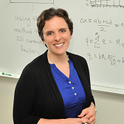Presentation
Student Approaches to Ambiguity while Working on a Community-Based Design Problem
Conference on Engineering Education for Sustainable Development
(2018)
Abstract
Community-based design can be a powerful tool for engaging students in the design process while providing them the means to have active involvement and communication with stakeholders. The use of communitybased design can be seen throughout engineering including the EPICS program at Purdue University and the Community-Engagement Based Design course at Harvey Mudd College. These approaches have the following benefits: supporting the retention of students, increasing diversity within programs, and preparing students for leadership roles in industry. Another feature of community-based design projects is that they are ill-defined and often open-ended, similar to problems students will face in industry. Exposure to this type of problem early in engineering programs can help students develop their problem solving and communication skills; however, many students struggle with the ambiguity and uncertainty associated with them.
In this pilot study, a sophomore level engineering design class at a mid-sized, public institution was redesigned to incorporate a user-oriented, community-based design project modeled after a course structure from Olin College of Engineering. Each team of 4-5 students identified campus problems and selected one to focus on. They then completed ethnographic observations and stakeholder interviews to create a customer persona, which helped them identify possible solutions to their customer’s problem.
Finally, teams selected one of those solutions and developed a minimum viable product or prototype. This pilot study sought to explore how students deal with ambiguity associated with a community-based design problem. To do so, students were invited to complete a survey to determine their comfort level with ambiguity and participate in a focus group to further elucidate how they approached their design problem.
Survey results demonstrated that students fell into four main statistically determined clusters defined by their level of closed-mindedness, discomfort with ambiguity, resistance to ambiguity in engineering, and resistance to multiple perspectives in engineering. Student clusters ranged from those students which clearly struggled with ambiguity and were closed-minded in nature to students that were more accepting of this illdefined environment and were willing to keep an open mind about how to approach problems. The focus group results further supported these categorizations with students commenting on the difficulty of getting started with the project due to the ill-defined nature of the problem and what they perceived as too broad of a scope. Despite these observed behaviors, students were aware of the importance of open-ended problems in their professional development and encouraged their use within the course.
Disciplines
Publication Date
June 6, 2018
Location
Glassboro, NJ
Citation Information
Cheryl A. Bodnar, Kaitlin E. Mallouk and Courtney June Faber. "Student Approaches to Ambiguity while Working on a Community-Based Design Problem" Conference on Engineering Education for Sustainable Development (2018) Available at: http://works.bepress.com/kaitlin-mallouk/10/
